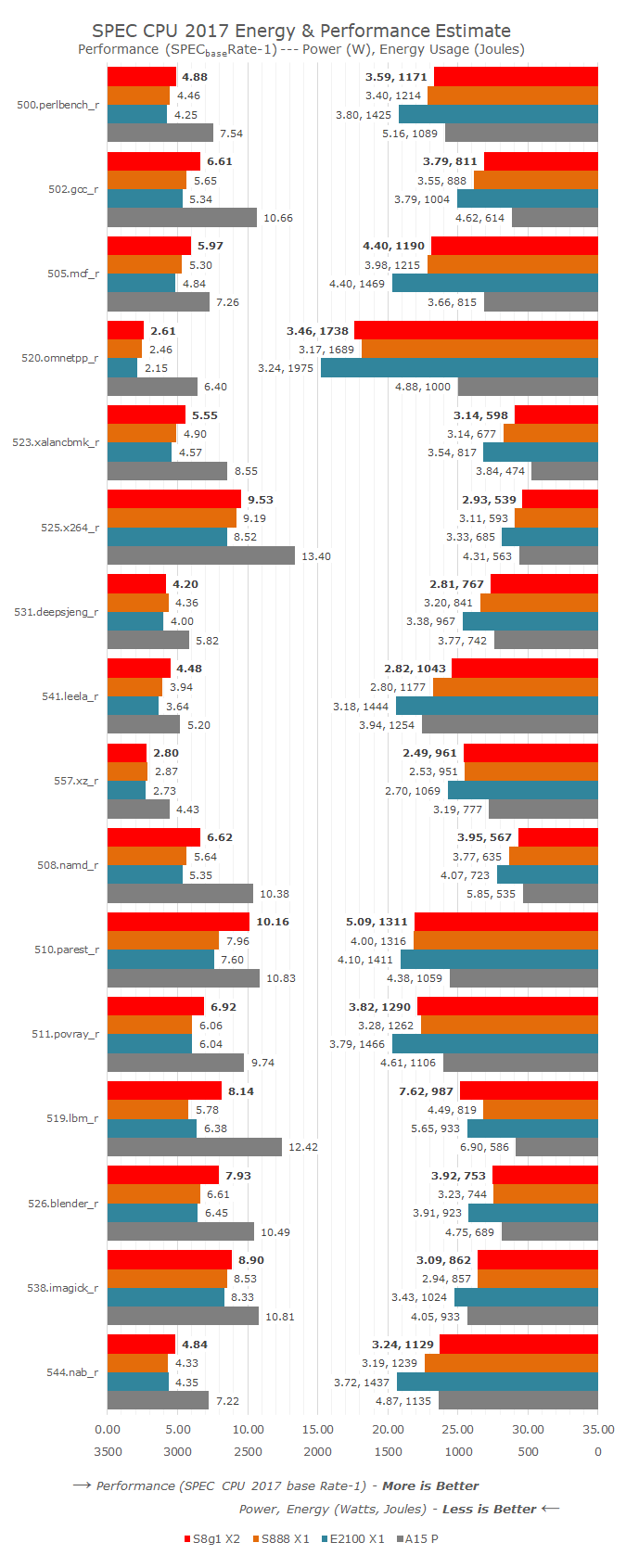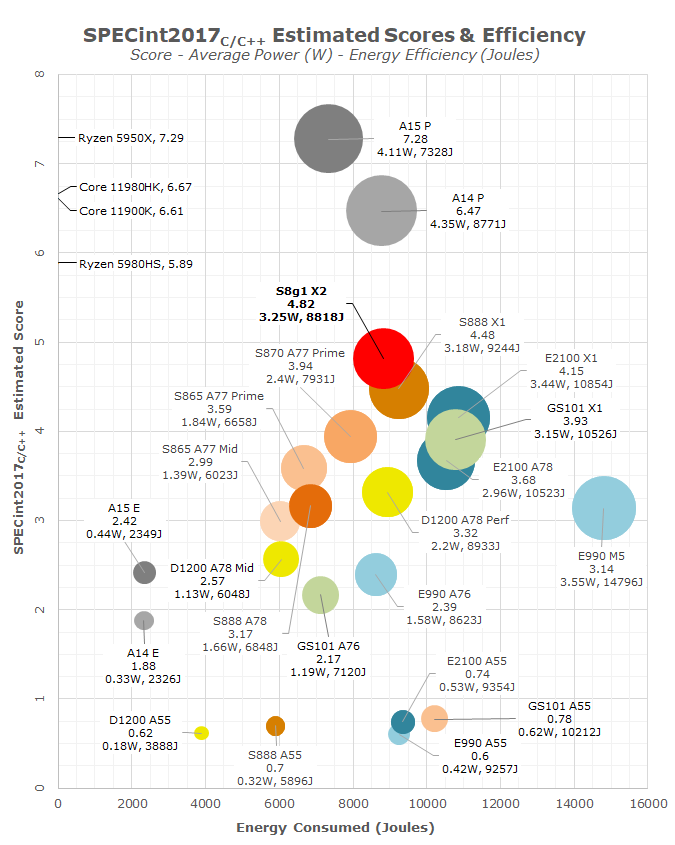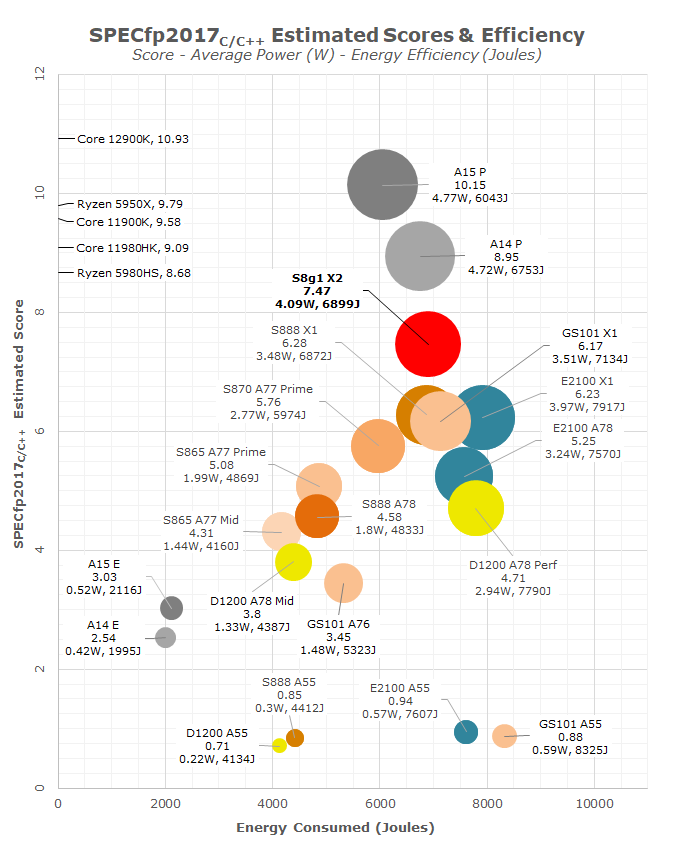The Snapdragon 8 Gen 1 Performance Preview: Sizing Up Cortex-X2
by Dr. Ian Cutress on December 14, 2021 8:00 AM ESTTesting the Cortex-X2: A New Android Flagship Core
Improving on the Cortex-X1 by switching to the Arm v9 architecture and increasing the core resources, both Arm and Qualcomm are keen to promote that the Cortex-X2 offers better performance and responsiveness than previous CPU cores. The small frequency bump from 2.85 GHz to 3.00 GHz will add some of that performance, however the question is always if the new manufacturing process coupled with the frequency increase allows for better power efficiency when running these workloads. Our standard analysis tool here is SPEC2017.
Running through some of these numbers, there are healthy gains to the core, and almost everything has a performance lift.
On the integer side (from 500.perlbench to 557.xr), there are good gains for gcc (+17%), mcf (+13%), xalancbmk (+13%), and leela (+14%), leading to an overall +8% improvement. Most of these integer tests involve cache movement and throughput, and usually gains in sub-tests like gcc can help a wide range of regular user workloads.
Looking at power and energy for the integer benchmarks, we’re seeing the X2 consume more instantaneous power on almost all the tests, but the efficiency is kicking in. That overall 8% performance gain is taking 5% less total energy, but on average requires 2% more peak power.
If we put this core up against all the other performance cores we test, we see that 8% jump in performance for 5% less energy used, and the X2 stands well above the X1 cores of the previous generation, especially those in non-Snapdragon processors. There is still a fundamental step needed to reach the Apple cores, even the previous-generation A14 performance core, which scores 34% higher for the same energy consumed (albeit on average another 34% peak power).
Just on these numbers, Qualcomm’s +20% performance or +30% efficiency doesn’t bare fruit, but the floating point numbers are significantly different.
Several benchmarks in 2017fp are substantially higher on the X2 this generation. +17% on namd for example would point to execution performance increases, but +28% in parest, +41% in lbm and +20% in blender showcases a mix of execution performance and memory performance. Overall we’re seeing +19% performance, which is nearer Qualcomm’s 20% mark. Note that this comes with an almost identical amount of energy consumed relative to the X1 core in the S888, with a difference of just 0.2%.
The major difference however is the average power consumed. For example, our biggest single test gain in 519.lbm is +41%, but where the S888 averages 4.49 watts, the new X2 core averages 7.62 watts. That’s a 70% increase in instantaneous power consumer, and realistically no single core in a modern smartphone should draw that much power. The reason why the power goes this high is because lbm leverages the memory subsystem, especially that 6 MiB L3 cache and relies on the 4 MiB system level cache, all of which consumes power. Overall in the lbm test, the +41% performance costs +20% energy, so efficiency is still +16% in this test. Some of the other tests, such as parest and blender, also follow this pattern.
Comparing against the competition, the X2 core does make a better generation jump when it comes to floating point performance. It will be interesting to see how other processors enable the X2 core, especially MTK’s flagship at slightly higher frequency, on TSMC N4, but also if it has access to a full 14 MiB combination of caches as we suspect, that could bring the power draw during single core use a lot higher. It will be difficult to tease out exactly who wins what where based on implementation vs. process node, but it will be a fun comparison to make when we look purely at the X2 vs. X2 cores.
Unfortunately due to how long SPEC takes to run (1h30 on the X2), we were unable to test on the A710/A510. We’ll have to wait to see when we get a retail unit.













169 Comments
View All Comments
Kangal - Sunday, December 19, 2021 - link
The best method used to be to:- buy Used
- buy ex-Flagship
- buy with good Custom Rom support
Now?
Flagship phones followed Apple's pricing, so used market is also less scarce and priced higher. Custom Rom community has also whimpered from its glory days (also lots of permanently locked bootloaders). And you can't replicate this tactic as often as previous (eg yearly or 18 months, is now 2+ years).
So getting an Android device either through Big Sales (eg Black Friday), and going for a lower ranked option (eg OnePlus 7t instead of 7t Pro) has become the go-to tactic. Just grab something that gives you as much value UPFRONT and hope you will get monthly security updates. Obtaining root or Custom ROMs is now considered bonus, mainly that most phones' firmware are Stock-ish and good enough. And keep that device as long as possible, until the upgrade to the next one is worthwhile (ie Display, Processor, Battery, Cameras, etc etc).
Reflex - Monday, December 20, 2021 - link
The issue though is that security updates are only every 2-3 years. Very weak in this day and age.Meteor2 - Friday, December 17, 2021 - link
Tbf, my mobile phones tend not to last past 2-3 years 😬. Screen might get damaged, more often battery degrades too far for my liking. It's a tough life for a li-ion in a phone, regularly 40+ C in summertime and almost always being rapid charged.Reflex - Friday, December 17, 2021 - link
I mean if that's your situation then yeah, support lifecycle means a lot less. My comments are really only for people who are not on the upgrade/replace bandwagon every 2 years. For those who need a new one (either cause they like the latest and greatest or because their phone is in rough situations routinely) this point I'm making does not apply.Nicon0s - Saturday, December 18, 2021 - link
"But that Android phone you mention comes with between 2-3 years of support before you are on your own"You are trying to make it sound that after new Android versions stop coming the phones becomes obsolete. That is very far from the truth.
Security risks are mitigated in a variety of ways on Android phones so he will still get security oriented updates through Project Mainline and Google Services long after the phones stops receiving OS updates.
"Meanwhile the iPhone 6S, released six years ago, just got iOS 15"
Which is runs quite poorly. iOS 14 run better on the 6s.
"A six year old phone will have a more functional lifespan than your brand new Xiaomi."
No it won't from a practical stand point.
"Apple is dirt cheap comparatively with 3-5x the support lifecycle for only 1.25x more money (using your comparison)."
And it's full of important hardware compromises.
Reflex - Monday, December 20, 2021 - link
Unclear what you mean here, I mean yes newer OS's tend to run a bit more sluggishly on old hardware, but that's where the superior Apple ARM implementation comes in: The same age android phone is not only out of support on any level but also runs terribly compared to the Apple device. Also, say you decided to stay back on iOS14 for a small perf gain, that *also* has another 3 years of support, meaning all you did was lose 1 total year to stay on your preferred OS.Meanwhile that Android device stopped getting major OS versions and security updates half a decade ago.
Nicon0s - Saturday, December 25, 2021 - link
"Unclear what you mean here, I mean yes newer OS's tend to run a bit more sluggishly on old hardware, but that's where the superior Apple ARM implementation comes in:"No it doesn't come in. I have a 2016 SE, iOS 15 performs worse than iOS 14 which performed worse than iOS 13. Not to mention the visual and feature differences are small.
"The same age android phone is not only out of support on any level but also runs terribly compared to the Apple device."
Such a discussion is irrelevant. People are not buying old phones in the present, people buy present phones in the present and Android phones have evolved enormously hardware wise in the last few years.
"Also, say you decided to stay back on iOS14 for a small perf gain, that *also* has another 3 years of support, meaning all you did was lose 1 total year to stay on your preferred OS."
On a phone like the 6s "a small perf gain" is the difference between the phone feeling fine and feeling sluggish and the phone feels sluggish with iOS 15 which I don't think anybody would be happy about.
"Meanwhile that Android device stopped getting major OS versions and security updates half a decade ago."
Again not relevant. I recently bough a 52s. How do you reckon my situation software wise is? Did I make the wrong decision?
Surfacround - Tuesday, December 21, 2021 - link
your spec is is wrong. it is a 48mp camera… https://www.gsmarena.com/xiaomi_mi_11x-10775.phpwhat else is wrong in your spec list?
tuxRoller - Tuesday, December 14, 2021 - link
Iphones have support for a long time, but the experience isn't a particularly great one, and it's not as if old iphones receive all the same software feature updates as the newer phones.That aside, Apple is obviously doing the best in this area.
Reflex - Wednesday, December 15, 2021 - link
Yes, and that's my point. I am not a huge fan of the UI although it's been improving. I'd like a simpler dev unlock procedure. I would like to have a few more things where I can set a preference.But I also have no interest in replacing my phone every 2-3 years anymore. And I cannot in good conscience give an Android device to a non-tech savvy user or senior given that they simply won't understand support lifecycle and will end up with a device that is easily compromised. Much better picking up a used iPhone off Swappa for such users.
I really hate that MS dropped out of this market, they met all the same criteria (security, support, ease of use) but had a better UI and more customization.